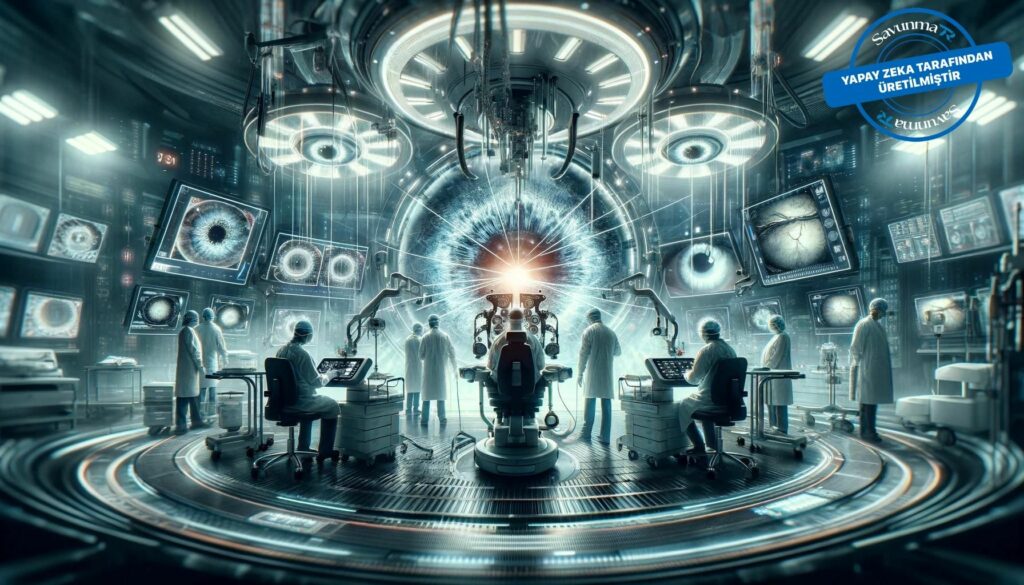HUMANITY, NATURE AND AI: THE LINE BETWEEN NATURAL AND ARTIFICIAL IS BLURRING
With its history spanning thousands of years, humanity has yet to clarify its relationship with nature. It has not developed a definitive rule of behavior regarding whether it is nature’s guest, master, or rival. Now, it debates the nature of its relationship with the algorithms it has designed itself.
It is widely acknowledged that artificial intelligence constitutes a new milestone, like the wheel, gunpowder, steam engine, and electricity, which have shaped human history. The discussion revolves around how many years it will take for artificial intelligence to transform the world and in what direction. However, those answering these critical questions are not just scientists and researchers. For a long time, artificial intelligence and related concepts have been a major area of interest for artists adept at redefining reality.
Through blockbuster films like Star Wars, Terminator, The Matrix, Avengers: Age of Ultron, I, Robot, and Dune, millions have witnessed how artificial intelligence and robots have shaped—or might shape—the world, whether in the present or historically. As a local example, I must also mention the film Japon İşi (1987), starring Kemal Sunal and Fatma Girik.
In the realm of fiction, artificial intelligence is sometimes portrayed as an ally capable of solving all problems and at other times as humanity’s greatest enemy. Generally speaking, however, it is easier for artists to focus on the potential negative aspects of technology.
Indeed, fictional threats such as artificial intelligence and digital technologies taking over humanity, large-scale wars between robots and humans, or the world regressing to a mechanically-based technology ecosystem—possibly even to its origins—carry a high perceived risk level.
The prevalence of minds shaped by the fears of the fictional realm, combined with the multifaceted nature of artificial intelligence and the challenges of thriving in this field, has led humanity—already struggling to fully embrace its authority, role, and responsibilities in the face of nature throughout its long history—into an even more complex process.

Amidst this complexity, trends such as minimal resource consumption, moving away from cities, returning to nature, and digital detox have gained popularity. At the same time, in line with the “quantified-self” trend, people are enabling more data collection and analysis regarding their daily lives and bodies. Particularly evident in the field of health, the quantified-self trend manifests itself through smart wearable devices that track data such as step count, heart rate, blood oxygen levels, blood glucose levels, and sleep patterns, and provide various analyses. [1]
This movement is only one aspect of “augmented humanity.” Potentially perceived as an unsettling concept, augmented humanity refers to efforts aimed at enabling “technologically enhanced humans” to unlock their full potential and perform at levels unattainable without technology, by creating an interaction between digital and physical worlds. [2]
In light of the current use of devices integrated into the human body, such as pacemakers, it can already be said that many people are “augmented humans.” However, with advancements in artificial intelligence and IoT, the capabilities and use of devices and sensors integrated into the human body are expected to grow. This will accelerate developments in Healthcare 5.0, with functions such as smart disease control, smart disease detection, smart monitoring, and smart decision-making. [3]
It is important to emphasize that sensors integrated into the human body provide higher precision and more accurate results compared to removable wearable devices. However, integrating such technologies directly into the human body requires overcoming specific or additional challenges such as biocompatibility, durability, signal transmission, and power supply. [4]
Nanobots, microscopic self-operating small robots, are expected to contribute significantly to processes like cancer treatment and the early diagnosis of various diseases (e.g., cancer and infectious diseases). Moreover, according to the European Technology Platform for Nanomedicine (ETPN), there are already over 80 products in the field of nanomedicine available in the market. [5]
AI-powered nanobots are not yet a fundamental part of our lives. Rapid short-term development in this area may not be feasible. Nonetheless, amid speculative discussions about humanity achieving immortality, significant scientific research is underway in the field.
Augmented humanity is increasingly emerging as a new societal phenomenon, blurring the line between natural and artificial. Hugh Herr, a lecturer at the Massachusetts Institute of Technology (MIT), lost both legs in a 1982 mountaineering accident. Through his work, he acquired bionic legs equipped with various sensors and microprocessors.
While Herr can move his bionic legs by thinking about it, he cannot feel them. He has stated that although he is a “bionic human,” he is not yet a “cyborg.” According to Herr, being a “cyborg” would require him to feel his bionic legs. However, Herr has led the development of a brain-controlled bionic leg for Jim Ewing, a climber who severely injured his leg in an accident, allowing full position and movement sensing. [6]
In a 2018 TEDx talk, Herr envisioned a futuristic future where wings could be attached to the human body. In a 2022 interview, he encouraged imagining a 75-year-old walking as if they were 18 again with the help of a special pair of shoes. In another interview, Herr speculated that in the future, anyone wearing external skeletal devices could run 160 miles (257.5 km) across any terrain without becoming breathless. [7]
Such radical predictions allow us to envision a future where we could complete a 252 km journey from Istanbul’s Üsküdar district to Bolu by running without tiring.
For over 40 million visually impaired people worldwide, advancements in bionic eyes are critically important. Even today, bionic eye surgeries for vision loss caused by certain diseases are successfully performed in Turkey and globally. However, scientists in this field are not focused on bringing individuals with disabilities to natural/normal limits. Existing bionic eyes enable seeing blurry and often difficult-to-interpret images.

At this point, Michael Beyeler, the director of the Bionic Vision Lab in the U.S., is working to develop an AI-powered “smart bionic eye.” Beyeler stated, “I imagine a smart bionic eye that can locate misplaced keys on a bench, read medicine labels, inform the user about people’s movements and facial expressions during social interactions, warn of nearby obstacles, and map safe paths.” [8]
The path toward augmented humanity has also garnered significant interest from technology billionaires. Bill Gates and Jeff Bezos are among the investors in Synchron, an Australian-based company specializing in brain-computer interfaces. Synchron enables decoding brain signals of paralyzed individuals and translating them into commands for external technologies through a system placed within blood vessels. With human trials already underway, this system allows users to control smart devices and computers using their thoughts. [9]
Synchron’s CEO, Tom Oxley, stated in September 2023 that the integration of the system costs between $50,000 and $100,000. The company is also working to incorporate AI capabilities into its systems. [10]
The brain-computer interface is also one of Elon Musk’s areas of interest. Known for his futuristic plans like establishing a colony on Mars, Musk has become a key player in challenging markets like self-driving cars and satellite internet. In February 2021, Musk invited his followers to join Neuralink, his brain-computer interface company. According to Musk, the company is addressing brain/spinal injuries in the short term, with long-term goals of achieving “human/AI symbiosis.” [11]
Unlike Synchron, Neuralink’s system must be implanted directly into the brain. Founded in 2016, Neuralink aims to treat neurological conditions like paralysis and blindness and improve the quality of life for individuals with disabilities through brain-implanted microchips. At the center of discussions on this topic, Neuralink announced in April 2024 that a paralyzed individual successfully played chess on a laptop using a chip implanted in their brain. [12]
With advancements in augmented humanity, we may witness the elimination of congenital or acquired physical disabilities through new technologies. However, attributing such outcomes solely to technological progress would be an incomplete evaluation, given that today’s global system has failed—or refused—to provide even basic necessities like food and clean water to all of humanity. Achieving such results fundamentally requires humanity to adhere to moral and ethical values.
Even assuming all societies have access to augmented humanity technologies, critical uncertainties remain:
- To what extent will humanity be enhanced, and how blurred will the line between natural and artificial become during this process?
- Could humanity manage the risk of hacking the human body in an era where ensuring cybersecurity for network infrastructures remains a challenge? Is such a risk acceptable?
- What is the role of governments in storing and analyzing health data voluntarily provided by citizens?
- Will people with challenges like mobility issues, color blindness, and speech difficulties reach the average abilities of healthy/normal individuals or exceed them through AI and augmented humanity technologies?
- Does artificial always offer the best outcomes compared to natural/normal?
- In the absence of a justification like eliminating disabilities, is the arbitrary alteration of human anatomy a feasible, reasonable, or desirable outcome?
Having yet to internalize its role in nature after thousands of years, can humanity develop global ethical values for coexisting with algorithms?
As humanity embarks on this journey toward augmented humanity, it is essential to recognize that potential “superhumans” may not be limited to physical abilities. According to some experts, combining augmented reality with artificial intelligence could provide humanity with sensory superpowers. For instance, through wearable devices like smart glasses or smart lenses, we may gain access to analyses in areas such as detecting whether someone is lying, their emotional states, financial power indicators, and signs of addiction. [13]
Although the ethics of such capabilities are a separate debate, the growing prevalence of wearable devices with the quantified-self trend and advancements in computer vision suggest that at least some of these features could be made available to end users in the medium term.
However, this vision of the future raises profound questions:
- Can we address the risk of hacking the human body in a world where even network security is challenging?
- What role should governments play in safeguarding and analyzing health data voluntarily shared by citizens?
- Should individuals with physical disabilities be enhanced to reach average or beyond-average human abilities through augmented humanity technologies?
- Does artificial enhancement always provide superior outcomes compared to natural capabilities?
- In the absence of pressing needs like eliminating disabilities, can arbitrary modifications to human anatomy be deemed desirable or ethical?
Humanity’s ethical alignment with these advancements will determine whether it can navigate the blurred boundaries of nature, technology, and augmented existence effectively.
Source: İnsanlık, Doğa ve Yapay Zeka (savunmatr.com)

